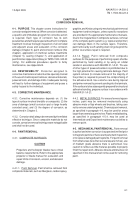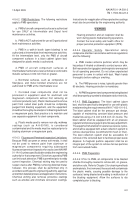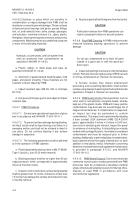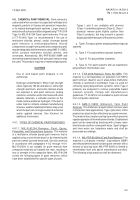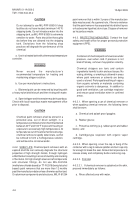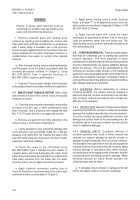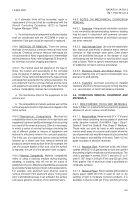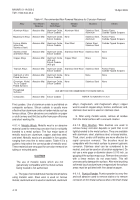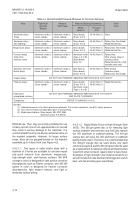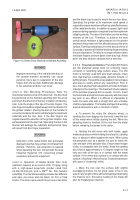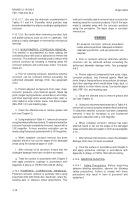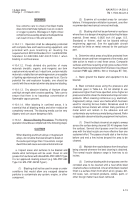TM-1-1500-344-23-2 - Page 87 of 240
4-11
NAVAIR 01-1A-509-2
TM 1-1500-344-23-2
15 April 2009
removal is allowed. It is mixed with water and then
rubbed over the area with a soft cloth. After drying, the
powder is wiped off.
4-9.1.7. Scrapers. Scrapers are used primarily for the
initial removal of heavy corrosion deposits in corners
and crevices that cannot be reached with other
equipment. Scrapers of this kind may be locally
manufactured from phenolic plastic, fiberglass
composites, aluminum or carbide-tipped steel. Plastic
scrapers may be used on any metal surfaces; aluminum
scrapers shall be used only on aluminum or magnesium
surfaces; and steel scrapers shall be used only on steel
surfaces. Failure to use the correct metal scraper can
lead to galvanic corrosion after the part is returned to
service. Normally, surface areas must receive further
finishing after corrosion removal with scrapers due to
the gouging action of scrapers and the difficulty in
determining complete corrosion removal.
WARN
I
NG
Power tool operations create toxic airborne
particles often containing heavy metals, such
as chromium (in the form of chromates), titanium,
nickel, and beryllium, depending on the surface
being treated. Eye protection, ventilation, and
an adequate respirator for dust control is
required. Do not use hands to probe for air
pressure leaks, as injury can result. Before
using any powered equipment, remove clothing
which might become entangled in the
equipment, as well as rings and other jewelry.
Always wear proper personal safety equipment,
such as goggles, faceshield, and/or respirator.
Ensure that all electrical equipment is grounded.
CAUTION
Corrosion removal accessories, such as bristle
discs, flap brushes, or rotary files, shall only be
used on one type of metal. For example, a flap
brush used to remove aluminum shall not be
used to remove magnesium or steel.
4-9.2. POWERED TOOLS AND MATERIALS. Power
tools are used to remove heavy corrosion from metal
surfaces, or mild to severe corrosion over large surface
areas. Their use results in savings of time and money.
However, care must be exercised when using power
tools. Application of excessive pressure can easily
damage metal surfaces and cause internal metallurgical
changes in the metal due to excessive heat buildup.
Powered tools are an aggressive method which shall
only be used when authorized by cognizant aircraft
engineering authority and where the extent of corrosion
makes non-powered corrosion removal impractical. The
indiscriminate use of powered corrosion removal
methods will result in damage to protective surface
finishes and excessive metal removal. Refer to Table 4-4
to determine the correct powered tools to use on various
aircraft metals.
CAUTION
Radial bristle discs are authorized for use only
on aluminum, magnesium, high-strength steel,
and titanium surfaces as a replacement/
substitute for abrasive wheels and brushes
cited in this chapter. Use of the discs on other
metallic or composite surfaces is not authorized
and may result in damage to the surface or
structure.
4-9.2.1. 3M™ Radial Bristle Disc. Bristle disc
technology has been proven to be effective and less
aggressive than abrasive wheels and brushes and is
intended for small corrosion repairs and paint removal.
Other commercial off-the-shelf radial bristle discs are
available, however, they have not been approved for
e
d
a
r
G
t
n
e
l
a
v
i
u
q
E
)
A
C
(
e
v
i
s
a
r
b
A
d
e
t
a
o
C
e
s
r
a
o
c
a
r
t
x
E0
0
1
-
0
8
e
s
r
a
o
C0
2
1
-
0
0
1
m
u
i
d
e
M0
5
1
-
0
2
1
e
n
i
F0
2
2
-
0
8
1
e
n
i
F
y
r
e
V0
2
3
-
0
8
2
e
n
i
F
r
e
p
u
S0
0
4
-
0
2
3
e
n
i
F
a
r
t
l
U0
0
5
-
0
0
4
t
n
i
l
F0
0
6
-
0
0
5
Table 4-2. Grades of Abrasive Mats
e
p
y
T
e
d
a
r
G
e
s
U
Ie
n
i
F
y
r
e
Vg
n
i
h
t
o
o
m
s
l
a
n
i
F
I
Ie
n
i
Fd
e
s
u
y
l
n
o
m
m
o
c
t
s
o
M
I
I
Im
u
i
d
e
Me
s
o
p
r
u
p
l
a
r
e
n
e
G
V
Ie
s
r
a
o
Ck
r
o
w
h
g
u
o
R
Ve
s
r
a
o
C
a
r
t
x
Ek
r
o
w
n
o
i
t
a
r
o
t
s
e
R
Table 4-3. Grades of Steel Wool
Back to Top

